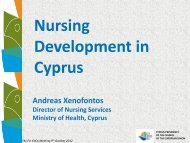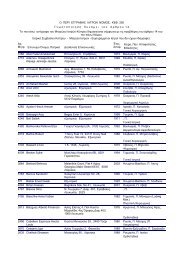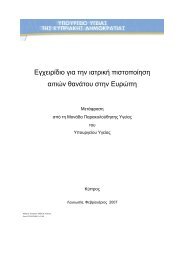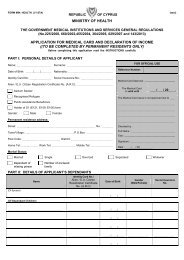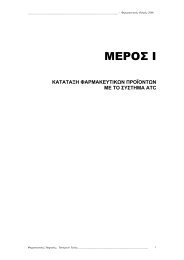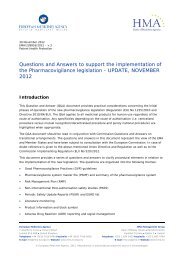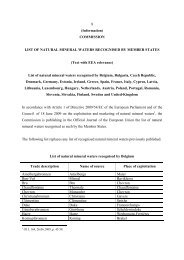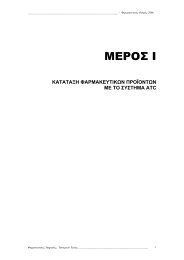Request for MAHs to assess the risk of
Request for MAHs to assess the risk of
Request for MAHs to assess the risk of
Create successful ePaper yourself
Turn your PDF publications into a flip-book with our unique Google optimized e-Paper software.
London, 27 th February 2008<br />
Doc. Ref.: EMEA/CMDh/98694/2008<br />
THE FOLLOWING LETTER IS INTENDED FOR<br />
ALL MARKETING AUTHORISATION HOLDERS<br />
FOR MEDICINAL PRODUCTS CONTAINING ACTIVE SUBSTANCES<br />
IN THE FORM OF MESILATES, (DI)ISETIONATES, TOSILATES<br />
OR BESILATES.<br />
REQUEST TO ASSESS THE RISK OF OCCURRENCE OF CONTAMINATION WITH MESILATE ESTERS<br />
AND RELATED COMPOUNDS IN PHARMACEUTICALS.<br />
Dear Sirs,<br />
Preclinical studies with certain mesilate esters have revealed that <strong>the</strong>ir DNA alkylation action can<br />
induce mutagenic, carcinogenic and tera<strong>to</strong>genic effects. This has been reported <strong>for</strong> methyl and ethyl<br />
mesilate and it is not unreasonable <strong>to</strong> suspect that similar <strong>to</strong>xic effects may exist in alkyl esters <strong>of</strong><br />
o<strong>the</strong>r low molecular weight sulfonic acids, e.g. <strong>to</strong>silates. Although <strong>the</strong>re are no data showing <strong>the</strong> <strong>to</strong>xic<br />
effect <strong>of</strong> such esters in humans, <strong>the</strong>re is never<strong>the</strong>less a potential <strong>risk</strong> that geno<strong>to</strong>xic substances as<br />
described above may be present as impurities in medicinal products containing active substances in <strong>the</strong><br />
<strong>for</strong>m <strong>of</strong> sulfonic acid esters.<br />
For this reason and following <strong>the</strong> recent case <strong>of</strong> mesilate ester contamination <strong>of</strong> Viracept, Competent<br />
Authorities requests all Marketing authorisation holders concerned <strong>to</strong> undertake a <strong>risk</strong> <strong>assess</strong>ment on<br />
<strong>the</strong> occurrence <strong>of</strong> <strong>the</strong>se impurities in <strong>the</strong>ir preparations and <strong>to</strong> in<strong>for</strong>m Competent Authorities should<br />
any <strong>risk</strong> be detected that requires corrective measures in <strong>the</strong> manufacture and control <strong>of</strong> <strong>the</strong> medicinal<br />
product. This <strong>risk</strong> <strong>assess</strong>ment should also include <strong>the</strong> procedure regarding <strong>the</strong> cleaning procedures and<br />
<strong>the</strong> used solvents etc.<br />
Below you will find some in<strong>for</strong>mation <strong>to</strong> help you in your <strong>risk</strong> <strong>assess</strong>ment.<br />
(1) In which preparations can mesilate esters (or alkyl mesilates) occur as impurities<br />
Alkyl mesilates, e.g. methanesulfonic acid methyl esters (MMS) and methanesulfonic acid ethyl esters<br />
(EMS), are esters <strong>of</strong> methanesulfonic acid with methanol, ethanol, or o<strong>the</strong>r lower alcohols. Alkyl<br />
mesilates can <strong>the</strong>re<strong>for</strong>e be found as potential impurities, in particular in active substances that occur as<br />
salts <strong>of</strong> methanesulfonic acid or mesilates or in active substances <strong>for</strong> which methanesulfonic acid is<br />
used in <strong>the</strong> syn<strong>the</strong>sis.<br />
(2) Are <strong>the</strong>re any o<strong>the</strong>r potentially dangerous sulfonic acid ester impurities that can occur in<br />
medicines<br />
The similar alkyl or aryl sulfonic ester contaminations could be found in active substances that are in<br />
<strong>the</strong> <strong>for</strong>m <strong>of</strong> (di)isetionates, besilates (benzenesulfonic acid esters) and <strong>to</strong>silates (<strong>to</strong>luene-p-sulfonic<br />
acid esters). The <strong>risk</strong> <strong>of</strong> <strong>the</strong>m occurring should <strong>the</strong>re<strong>for</strong>e be clarified.
(3) Is <strong>the</strong>re a threshold value <strong>for</strong> <strong>the</strong>se impurities, under which <strong>the</strong> <strong>risk</strong> is negligible Which<br />
limits should be used<br />
In <strong>the</strong> absence <strong>of</strong> o<strong>the</strong>r <strong>to</strong>xicological data <strong>the</strong> TTC (threshold <strong>of</strong> <strong>to</strong>xicological concern) <strong>for</strong> geno<strong>to</strong>xic<br />
impurities (cf. EMEA guidelines ‘Limits <strong>for</strong> Geno<strong>to</strong>xic Impurities’ EMEA/CHMP/QWP/251334/2006)<br />
should be used <strong>to</strong> set limits.<br />
(Calculating <strong>the</strong> limits <strong>to</strong> be applied: 1.5 micrograms divided by <strong>the</strong> maximum daily dose in grams<br />
gives <strong>the</strong> limit in ppm <strong>to</strong> be applied <strong>to</strong> <strong>the</strong> active substance).<br />
(4) What legislative basis is <strong>the</strong>re <strong>for</strong> restricting alkyl mesilates in pharmaceutical active<br />
substances<br />
In all monographs <strong>for</strong> active substances that are present in <strong>the</strong> <strong>for</strong>m <strong>of</strong> mesilates and diisetionates <strong>the</strong><br />
European Pharmacopoeia requires <strong>the</strong> following safety measures <strong>to</strong> be applied in <strong>the</strong> manufacturing<br />
process:<br />
„The production method must be evaluated <strong>to</strong> determine <strong>the</strong> potential <strong>for</strong>mation <strong>of</strong> alkyl mesilates<br />
(respectively alkyl diisetionates), which is particularly likely <strong>to</strong> occur if <strong>the</strong> reaction medium contains<br />
lower alcohols. Where necessary, <strong>the</strong> production method is validated <strong>to</strong> demonstrate that alkyl<br />
mesilates (respectively alkyl diisetionates) are not detectable in <strong>the</strong> final product.“<br />
(5) How can <strong>the</strong>se requirements be put in<strong>to</strong> practice<br />
The production and s<strong>to</strong>rage <strong>of</strong> <strong>the</strong> active substances and preparations concerned should be subjected <strong>to</strong><br />
a <strong>risk</strong> analysis taking account <strong>of</strong> <strong>the</strong> following points (not an exhaustive list) .<br />
• Does <strong>the</strong> production <strong>of</strong> <strong>the</strong> active ingredient involve <strong>the</strong> use <strong>of</strong> lower aliphatic alcohols, such as<br />
methanol, ethanol, n-propanol, or isopropanol, in <strong>the</strong> presence <strong>of</strong> methanesulfonic acid (or isetionic<br />
acid, benzolsulfonic acid, para<strong>to</strong>luolsulfonic acid) or <strong>the</strong> corresponding acid chlorides If so, is <strong>the</strong><br />
<strong>for</strong>mation <strong>of</strong> alkyl mesilates or <strong>the</strong> analogous alkyl besilates and alkyl <strong>to</strong>silates minimized and is<br />
followed by an efficient purification stage<br />
Does <strong>the</strong> cleaning procedures <strong>for</strong> equipments, particularly those in contact <strong>of</strong> sulfonic acid reagents<br />
involve <strong>the</strong> use <strong>of</strong> lower aliphatic alcohols<br />
• Are appropriate specifications and validated testing methods available <strong>to</strong> verify <strong>the</strong> alkyl- or<br />
arylsulfonic acid ester impurities in <strong>the</strong> active substance (at <strong>the</strong>TTC)<br />
• Is <strong>the</strong> quality <strong>of</strong> <strong>the</strong> starting materials methanesulfonic acid (benzolsulfonic acid, para<strong>to</strong>luolsulfonic<br />
acid, isetionic acid) checked <strong>for</strong> alkyl- or arylsulfonic acid ester impurities (e.g. EMS and MMS in<br />
methanesulfonic acid) and <strong>the</strong> corresponding acid chlorides Are appropriate specifications and<br />
validated testing methods available <strong>for</strong> this<br />
• Is it ensured that when using sulfonic acids contaminated with sulfonic acid esters or related<br />
compounds as <strong>the</strong> starting materials <strong>for</strong> producing <strong>the</strong> active ingredient <strong>the</strong> TTC <strong>for</strong> <strong>the</strong> potential<br />
geno<strong>to</strong>xic impurities in <strong>the</strong> active substance is not exceeded The cumulative <strong>risk</strong> <strong>of</strong> various alkyl- or<br />
aryl-substituted sulfonic acid ester impurities should be taken in<strong>to</strong> account.<br />
• If a sulfonic acid derivative is used in one <strong>of</strong> <strong>the</strong> last stages <strong>of</strong> syn<strong>the</strong>sis during production <strong>of</strong> <strong>the</strong><br />
active substance, this should be included in <strong>the</strong> <strong>risk</strong> analysis.<br />
• Is <strong>the</strong> quality <strong>of</strong> recycled solvents controlled <strong>for</strong> <strong>the</strong> enrichment and carry-over <strong>of</strong> sulfonic acid ester<br />
impurities (e.g. EMS in ethanol, MMS in methanol, IMS in isopropanol)<br />
• Can <strong>the</strong> <strong>for</strong>mation <strong>of</strong> alkyl- or aryl-sulfonic acid esters be excluded during <strong>the</strong> s<strong>to</strong>rage <strong>of</strong> an active<br />
substance that exists in <strong>the</strong> <strong>for</strong>m <strong>of</strong> a mesilate, besilate, <strong>to</strong>silate or isetionate/diisetionate, or in <strong>the</strong><br />
related preparation<br />
• Can <strong>the</strong> <strong>for</strong>mation <strong>of</strong> alkyl- or aryl-sulfonic acid esters be excluded during <strong>the</strong> processing <strong>of</strong> mesilate,<br />
disetionate, besilate or <strong>to</strong>silate active substances <strong>to</strong> make <strong>the</strong> finished preparation, e.g. when using<br />
alcohols <strong>for</strong> granulation Is a sufficiently sensitive method available <strong>to</strong> detect <strong>the</strong>se impurities in <strong>the</strong><br />
pharmaceutical dosage <strong>for</strong>m (at <strong>the</strong> TTC)<br />
EMEA/CMDh/98694/2008 Page 2/3
(6) In which cases should <strong>the</strong> results <strong>of</strong> <strong>the</strong> <strong>risk</strong> analysis carried out under (5) and <strong>the</strong> related<br />
investigations be reported <strong>to</strong> Competent Authorities <br />
The Marketing Authorisation Holder <strong>for</strong> <strong>the</strong> finished product is responsible <strong>for</strong> carrying out <strong>the</strong> <strong>risk</strong><br />
analysis.The in<strong>for</strong>mation necessary <strong>for</strong> <strong>risk</strong> <strong>assess</strong>ment should be made available <strong>to</strong> <strong>the</strong> Marketing<br />
Authorisation Holder by <strong>the</strong> manufacturers involved in <strong>the</strong> galenic production and in particular by <strong>the</strong><br />
manufacturers <strong>of</strong> <strong>the</strong> active substance.<br />
If <strong>the</strong>re is a related <strong>risk</strong> that must be controlled by making changes <strong>to</strong> <strong>the</strong> production process or by<br />
means <strong>of</strong> specifications, any changes <strong>to</strong> <strong>the</strong> marketing authorisation that require amendment <strong>to</strong> <strong>the</strong><br />
method <strong>of</strong> manufacture or control <strong>of</strong> <strong>the</strong> active substance and/or finished product must be submitted <strong>to</strong><br />
Competent Authorities using <strong>the</strong> relevant procedure <strong>for</strong> <strong>assess</strong>ment, with a justified timetable <strong>for</strong> <strong>the</strong><br />
submission <strong>of</strong> <strong>the</strong> variations(s) needed.<br />
The <strong>risk</strong> analysis should be made available by <strong>the</strong> Marketing Authorisation Holder upon request from<br />
any Competent Authority.<br />
Yours faithfully,<br />
Truus Janse-de Hoog<br />
Chair <strong>of</strong> CMD(h)<br />
EMEA/CMDh/98694/2008 Page 3/3





